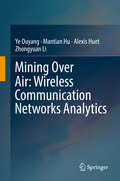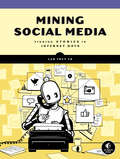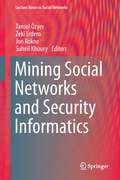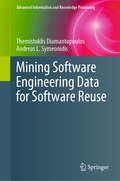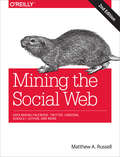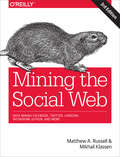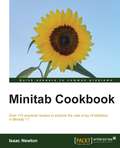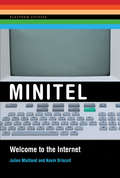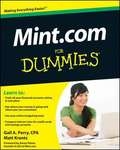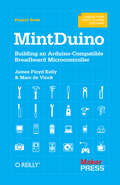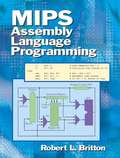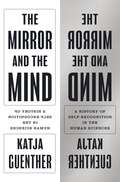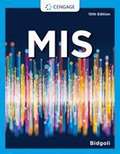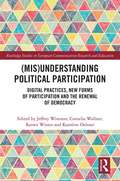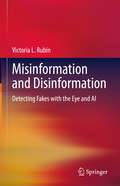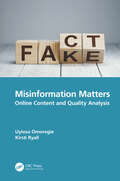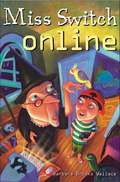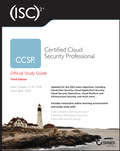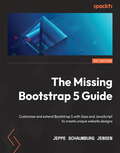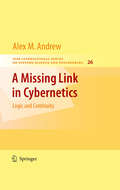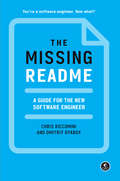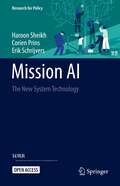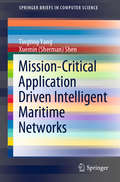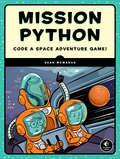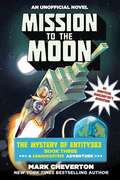- Table View
- List View
Mining Over Air: Wireless Communication Networks Analytics
by Ye Ouyang Mantian Hu Alexis Huet Zhongyuan LiThis book introduces the concepts, applications and development of data science in the telecommunications industry by focusing on advanced machine learning and data mining methodologies in the wireless networks domain. Mining Over Air describes the problems and their solutions for wireless network performance and quality, device quality readiness and returns analytics, wireless resource usage profiling, network traffic anomaly detection, intelligence-based self-organizing networks, telecom marketing, social influence, and other important applications in the telecom industry. Written by authors who study big data analytics in wireless networks and telecommunication markets from both industrial and academic perspectives, the book targets the pain points in telecommunication networks and markets through big data. Designed for both practitioners and researchers, the book explores the intersection between the development of new engineering technology and uses data from the industry to understand consumer behavior. It combines engineering savvy with insights about human behavior. Engineers will understand how the data generated from the technology can be used to understand the consumer behavior and social scientists will get a better understanding of the data generation process.
Mining Social Media: Finding Stories in Internet Data
by Lam Thuy VoBuzzFeed News Senior Reporter Lam Thuy Vo explains how to mine, process, and analyze data from the social web in meaningful ways with the Python programming language.Did fake Twitter accounts help sway a presidential election? What can Facebook and Reddit archives tell us about human behavior? In Mining Social Media, senior BuzzFeed reporter Lam Thuy Vo shows you how to use Python and key data analysis tools to find the stories buried in social media.Whether you're a professional journalist, an academic researcher, or a citizen investigator, you'll learn how to use technical tools to collect and analyze data from social media sources to build compelling, data-driven stories.Learn how to: • Write Python scripts and use APIs to gather data from the social web • Download data archives and dig through them for insights • Inspect HTML downloaded from websites for useful content • Format, aggregate, sort, and filter your collected data using Google Sheets • Create data visualizations to illustrate your discoveries • Perform advanced data analysis using Python, Jupyter Notebooks, and the pandas library • Apply what you've learned to research topics on your ownSocial media is filled with thousands of hidden stories just waiting to be told. Learn to use the data-sleuthing tools that professionals use to write your own data-driven stories.
Mining Social Networks and Security Informatics
by Zeki Erdem Jon Rokne Suheil Khoury Tansel ÖzyerCrime, terrorism and security are in the forefront of current societal concerns. This edited volume presents research based on social network techniques showing how data from crime and terror networks can be analyzed and how information can be extracted. The topics covered include crime data mining and visualization; organized crime detection; crime network visualization; computational criminology; aspects of terror network analyses and threat prediction including cyberterrorism and the related area of dark web; privacy issues in social networks; security informatics; graph algorithms for social networks; general aspects of social networks such as pattern and anomaly detection; community discovery; link analysis and spatio-temporal network mining. These topics will be of interest to researchers and practitioners in the general area of security informatics. The volume will also serve as a general reference for readers that would want to become familiar with current research in the fast growing field of cybersecurity.
Mining Software Engineering Data for Software Reuse (Advanced Information and Knowledge Processing)
by Andreas L. Symeonidis Themistoklis DiamantopoulosThis monograph discusses software reuse and how it can be applied at different stages of the software development process, on different types of data and at different levels of granularity. Several challenging hypotheses are analyzed and confronted using novel data-driven methodologies, in order to solve problems in requirements elicitation and specification extraction, software design and implementation, as well as software quality assurance. The book is accompanied by a number of tools, libraries and working prototypes in order to practically illustrate how the phases of the software engineering life cycle can benefit from unlocking the potential of data. Software engineering researchers, experts, and practitioners can benefit from the various methodologies presented and can better understand how knowledge extracted from software data residing in various repositories can be combined and used to enable effective decision making and save considerable time and effort through software reuse. Mining Software Engineering Data for Software Reuse can also prove handy for graduate-level students in software engineering.
Mining the Social Web: Data Mining Facebook, Twitter, LinkedIn, Google+, GitHub, and More
by Matthew A. RussellWant to tap the tremendous amount of valuable social data in Facebook, Twitter, LinkedIn, and Google+? This refreshed edition helps you discover who's making connections with social media, what they're talking about, and where they're located. You'll learn how to combine social web data, analysis techniques, and visualization to find what you've been looking for in the social haystack--as well as useful information you didn't know existed. Each standalone chapter introduces techniques for mining data in different areas of the social Web, including blogs and email. All you need to get started is a programming background and a willingness to learn basic Python tools. Get a straightforward synopsis of the social web landscape Use adaptable scripts on GitHub to harvest data from social network APIs such as Twitter, Facebook, LinkedIn, and Google+ Learn how to employ easy-to-use Python tools to slice and dice the data you collect Explore social connections in microformats with the XHTML Friends Network Apply advanced mining techniques such as TF-IDF, cosine similarity, collocation analysis, document summarization, and clique detection Build interactive visualizations with web technologies based upon HTML5 and JavaScript toolkits "A rich, compact, useful, practical introduction to a galaxy of tools, techniques, and theories for exploring structured and unstructured data." --Alex Martelli, Senior Staff Engineer, Google
Mining the Social Web: Data Mining Facebook, Twitter, LinkedIn, Instagram, GitHub, and More
by Matthew A. Russell Mikhail KlassenMine the rich data tucked away in popular social websites such as Twitter, Facebook, LinkedIn, and Instagram. With the third edition of this popular guide, data scientists, analysts, and programmers will learn how to glean insights from social media—including who’s connecting with whom, what they’re talking about, and where they’re located—using Python code examples, Jupyter notebooks, or Docker containers.In part one, each standalone chapter focuses on one aspect of the social landscape, including each of the major social sites, as well as web pages, blogs and feeds, mailboxes, GitHub, and a newly added chapter covering Instagram. Part two provides a cookbook with two dozen bite-size recipes for solving particular issues with Twitter.Get a straightforward synopsis of the social web landscapeUse Docker to easily run each chapter’s example code, packaged as a Jupyter notebookAdapt and contribute to the code’s open source GitHub repositoryLearn how to employ best-in-class Python 3 tools to slice and dice the data you collectApply advanced mining techniques such as TFIDF, cosine similarity, collocation analysis, clique detection, and image recognitionBuild beautiful data visualizations with Python and JavaScript toolkits
Minitab Cookbook
by Isaac NewtonThis practical cookbook covers a broad range of topics in an easy-to-understand manner. Step-by-step instructions guide you through even the most complicated of tools in Minitab. This book is great for anyone who is familiar with statistics and who wants to learn how Minitab works. Whilst you do not need to be an expert in all areas of statistics, you should understand the basics of the chapters you are interested in.
Minitel: Welcome to the Internet (Platform Studies)
by Julien Mailland Kevin DriscollThe first scholarly book in English on Minitel, the pioneering French computer network, offers a history of a technical system and a cultural phenomenon.A decade before the Internet became a medium for the masses in the United States, tens of millions of users in France had access to a network for e-mail, e-commerce, chat, research, game playing, blogging, and even an early form of online porn. In 1983, the French government rolled out Minitel, a computer network that achieved widespread adoption in just a few years as the government distributed free terminals to every French telephone subscriber. With this volume, Julien Mailland and Kevin Driscoll offer the first scholarly book in English on Minitel, examining it as both a technical system and a cultural phenomenon. Mailland and Driscoll argue that Minitel was a technical marvel, a commercial success, and an ambitious social experiment. Other early networks may have introduced protocols and software standards that continue to be used today, but Minitel foretold the social effects of widespread telecomputing. They examine the unique balance of forces that enabled the growth of Minitel: public and private, open and closed, centralized and decentralized. Mailland and Driscoll describe Minitel's key technological components, novel online services, and thriving virtual communities. Despite the seemingly tight grip of the state, however, a lively Minitel culture emerged, characterized by spontaneity, imagination, and creativity. After three decades of continuous service, Minitel was shut down in 2012, but the history of Minitel should continue to inform our thinking about Internet policy, today and into the future.
Mint.com For Dummies
by Gail A. Perry CPA Matt KrantzGet empowered and take control of your personal finances with Mint.com!Mint.com is a free Web-based personal financial management service that helps you set up your day-to-day finances and track bank, credit card, investment, and loan transactions through a single Web site that is accessible anytime, anywhere in the world that you can access through the Internet. This fun and friendly guide arms you with expert advice for managing your bills, following where your money is going, developing a budget, paying off loans, saving for a house or car, maximizing investments, managing retirement savings, and more. The straightforward and easy-to-understand Dummies writing style shows you how to use Mint.com to get your finances organized--and keep them that way.Introduces you to Mint.com, the free personal online finance management service that helps you set up and track your day-to-day financesWalks you through the steps for creating a budget based on your current spending habits or creating a budget with goals in mind (saving for a new home or car, paying off college loans early, having a comfortable retirement, etc.)Tells you everything you need to do to track bank, credit card, investments, loan transactions and manage your billsShows you how to import and export tax information from Mint.com, including the tax software packages that make it the easiestIncludes handy checklists, expert tips, invaluable advice, and helpful warnings throughoutMint.com For Dummies helps you get your daily finances in mint condition!
MintDuino: Building an Arduino-Compatible Breadboard Microcontroller
by James Floyd Kelly Marc De VinckGet started with MintDuino, the Maker Shed kit that's perfect for learning or teaching the fundamentals of how microcontrollers work. This hands-on book shows you how to build a complete MintDuino project from start to finish. Learn how to assemble the microcontroller on a breadboard (no soldering required), and immediately begin programming it. You'll build the MintDuino Reflex Game in five separate stages or sub-tasks. Breaking down a large project into manageable tasks helps you track down errors quickly, and lets you see how each part of the circuit works. Once you complete the game, you'll have the resources and experience to tackle more MintDuino projects. If you're interested in the fascinating world of microcontrollers, you'll enjoy this book. Wire up and program the MintDuino to light an LED Build a game that tests the reflexes of two players Learn how to make your "game light" glow at random intervals Construct a pushbutton circuit to control individual players' LEDs Put all of the components together, including simple code to control your game
MIPS Assembly Language Programming
by Robert BrittonUsers of this book will gain an understanding of the fundamental concepts of contemporary computer architecture, starting with a Reduced Instruction Set Computer (RISC).
The Mirror and the Mind: A History of Self-Recognition in the Human Sciences (Princeton Modern Knowledge Ser. #2)
by Professor Katja GuentherHow the classic mirror test served as a portal for scientists to explore questions of self-awarenessSince the late eighteenth century, scientists have placed subjects—humans, infants, animals, and robots—in front of mirrors in order to look for signs of self-recognition. Mirrors served as the possible means for answering the question: What makes us human? In The Mirror and the Mind, Katja Guenther traces the history of the mirror self-recognition test, exploring how researchers from a range of disciplines—psychoanalysis, psychiatry, developmental and animal psychology, cybernetics, anthropology, and neuroscience—came to read the peculiar behaviors elicited by mirrors. Investigating the ways mirrors could lead to both identification and misidentification, Guenther looks at how such experiments ultimately failed to determine human specificity.The mirror test was thrust into the limelight when Charles Darwin challenged the idea that language sets humans apart. Thereafter the mirror, previously a recurrent if marginal scientific tool, became dominant in attempts to demarcate humans from other animals. But because researchers could not rely on language to determine what their nonspeaking subjects were experiencing, they had to come up with significant innovations, including notation strategies, testing protocols, and the linking of scientific theories across disciplines. From the robotic tortoises of Grey Walter and the mark test of Beulah Amsterdam and Gordon Gallup, to anorexia research and mirror neurons, the mirror test offers a window into the emergence of such fields as biology, psychology, psychiatry, animal studies, cognitive science, and neuroscience.The Mirror and the Mind offers an intriguing history of experiments in self-awareness and the advancements of the human sciences across more than a century.
MIS
by Hossein BidgoliLearn the principles of MIS as you explore the latest developments and industry trends with MIS 10. This practically focused approach helps you master foundational MIS concepts that will guide your career. You examine the latest topics, such as cloud computing, AR/VR, quantum computing and blockchain, with the most current MIS title on the market. Have you ever wondered what you would have done as a company leader in a critical moment? With this edition's MindTap digital experience, you can strengthen your decision-making skills with "YouDecide" -- new interactive case studies that bridge technology and business strategy and position you as the decision maker.
: Digital Practices, New Forms of Participation and the Renewal of Democracy (Routledge Studies in European Communication Research and Education)
by Jeffrey Wimmer Cornelia Wallner Rainer Winter Karoline OelsnerThe practices of participation and engagement are characterised by complexities and contradictions. All celebratory examples of uses of social media, e.g. in the Arab spring, the Occupy movement or in recent LGBTQ protests, are deeply rooted in human practices. Because of this connection, every case of mediated participation should be perceived as highly contextual and cannot be attributed to one (social) specific media logic, necessitating detailed empirical studies to investigate the different contexts of political and civic engagement. In this volume, the theoretical chapters discuss analytical frameworks that can enrich our understanding of current contexts and practices of mediated participation. The empirical studies explore the implications of the new digital conditions for the ways in which digitally mediated social interactions, practices and environments shape everyday participation, engagement or protest and their subjective as well societal meaning.
Misinformation and Disinformation: Detecting Fakes with the Eye and AI
by Victoria L. RubinThis book, geared towards both students and professionals, examines the synthesis of artificial intelligence (AI) and psychology in detecting mis-/disinformation in digital media content, and suggests practical means to intervene and curtail this current global ‘infodemic’. This interdisciplinary book explores technological, psychological, philosophical, and linguistic insights into the nature of truth and deception, trust and credibility, cognitive biases and logical fallacies and how, through AI and human intervention, content users can be alerted to the presence of deception. The author investigates how AI can mimic the procedures and know-hows of humans, showing how AI can help spot fakes and how AI tools can work to debunk rumors and fact-check. The book describes how AI detection systems work and how they fit with broader societal and individual concerns. Each chapter focuses attention on key concepts and their inter-connection. The first part of the book seeks theoretical footing to understand our interactions with new information and reviews relevant empirical findings in behavioral sciences. The second part is about applied knowledge. The author looks at several known practices that guard us against deception, and provides several real-world examples of manipulative persuasive techniques in advertising, political propaganda, and public relations. She provides links to the downloadable executable files to three AI applications (clickbait, satire, and falsehood detectors) via LiT.RL GitHub, an open access repository. The book is useful to students and professionals studying AI and media studies as well as library and information professionals.Examines how artificial intelligence (AI) and psychology can aid in detecting mis-/disinformation and the language of deceit in digital media content;Suggests practical computational means to intervene and curtail the global ‘infodemic’ of fake news;Presents how AI can sift, sort, and shuffle digital content, to reduce the amount of content needed to be reviewed by humans.
Misinformation Matters: Online Content and Quality Analysis
by Uyiosa Omoregie Kirsti RyallWhat is "misinformation"? Why does it matter? How does it spread on the internet, especially on social media platforms? What can we do to counteract the worst of its effects? Can we counteract its effects now that it is ubiquitous? These are the questions we answer in this book. We are living in an information age (specifically an "algorithmic age") which prioritizes information "quantity" over "quality". Social media has brought billions of people from across the world together online and the impact of diverse platforms, such as Facebook, WeChat, Reddit, LinkedIn, Signal, WhatsApp, Gab, Instagram, Telegraph, and Snapchat, has been transformational. The internet was created, with the best of intentions, as an online space where written content could be created, consumed and diffused without any real intermediary. This empowering aspect of the web is still, mostly, a force for good. People, on the whole, are better informed and online discussion is more inclusive because barriers to participation are reduced. As activity online has grown, however, an expanding catalogue of research reveals a darker side to social media, and the internet generally. Namely, misinformation’s ability to negatively influence our behaviour both online and offline. The solution we provide to this growing dilemma is informed by Ludwig Wittgenstein’s Tractatus Logico-Philosophicus, which examines the relationship between language and reality from a philosophical perspective, and complements Claude Shannon’s Information Quantity Theory, which addresses the quantification, storage and communication of digital information from a mathematical perspective. The book ends by setting out a model designed by us: a "Wittgensteinian" approach to information quality. It defines content published online by clarifying the propositions and claims made within it. Our model’s online information quality check allows users to effectively analyse the quality of trending online content. This approach to misinformation analysis and prevention has been designed to be both easy to use and pragmatic. It upholds freedom of speech online while using the "harm principle" to categorise problematic content.
Miss Switch Online
by Barbara Brooks WallaceFifth grade was a year full of flying brooms, spells-gone-wrong, and general craziness for Rupert P. Brown III. Sixth grade should be a little more normal, right? Wrong! Sixth grade brings a new teacher named Miss Blossom, a principal who is every girl's crush, a bird who's got a thing for math, and a whacked-out computer that leads Rupert to a Web site called computowitch.com -- with a password that's also the name of an evil witch from Rupert's past! As clever as he is, Rupert can probably use some help -- and who better to assist than his favorite bewitching teacher, Miss Switch?
**Missing** (Sybex Study Guide Ser.)
by Mike Chapple David SeidlThe only official study guide for the new CCSP exam objectives effective from 2022-2025 (ISC)2 CCSP Certified Cloud Security Professional Official Study Guide, 3rd Edition is your ultimate resource for the CCSP exam. As the only official study guide reviewed and endorsed by (ISC)2, this guide helps you prepare faster and smarter with the Sybex study tools that include pre-test assessments that show you what you know, and areas you need further review. In this completely rewritten 3rd Edition, experienced cloud security professionals Mike Chapple and David Seidl use their extensive training and hands on skills to help you prepare for the CCSP exam. Objective maps, exercises, and chapter review questions help you gauge your progress along the way, and the Sybex interactive online learning environment includes access to a PDF glossary, hundreds of flashcards, and two complete practice exams. Covering all CCSP domains, this book walks you through Cloud Concepts, Architecture and Design, Cloud Data Security, Cloud Platform and Infrastructure Security, Cloud Application Security, Cloud Security Operations, and Legal, Risk, and Compliance with real-world scenarios to help you apply your skills along the way. The CCSP credential from (ISC)2 and the Cloud Security Alliance is designed to show employers that you have what it takes to keep their organization safe in the cloud. Learn the skills you need to be confident on exam day and beyond. Review 100% of all CCSP exam objectives Practice applying essential concepts and skills Access the industry-leading online study tool set Test your knowledge with bonus practice exams and moreAs organizations become increasingly reliant on cloud-based IT, the threat to data security looms larger. Employers are seeking qualified professionals with a proven cloud security skillset, and the CCSP credential brings your resume to the top of the pile. (ISC)2 CCSP Certified Cloud Security Professional Official Study Guide gives you the tools and information you need to earn that certification and apply your skills in a real-world setting.
The Missing Bootstrap 5 Guide: Customize and extend Bootstrap 5 with Sass and JavaScript to create unique website designs
by Jeppe Schaumburg JensenMake your website stand out by unlocking the full potential of Bootstrap 5 and creating efficient UIsKey FeaturesFind out how to customize all parts of Bootstrap 5 with Sass, including working with the utility APICreate a unique website using only Bootstrap 5 with Sass customization and interactive featuresGrasp advanced Bootstrap 5 topics related to Sass, CSS, JavaScript, and source code optimizationBook DescriptionBootstrap is one of the world's most popular and easy-to-use frontend UI toolkits for building responsive websites, but few know how to get the most out of its vast range of components, utilities, JavaScript plugins, and other features. The Missing Bootstrap 5 Guide will help you customize Bootstrap 5 with Sass to achieve a layout that stands out from the crowd, enabling you to create something unique that doesn't look like it was created with Bootstrap.With this practical guide to Bootstrap customization, developers working with Bootstrap will be able to utilize powerful customization techniques to create websites with unique designs and exclusive features. You'll see how you can develop a visually appealing website quickly and easily by taking a hands-on approach to customizing your website using advanced features of CSS, Sass, and JavaScript. Starting with learning how the Bootstrap 5 visual style is created with Sass, you'll find out how to customize it to fit your needs while achieving the website look you want. You'll then use this knowledge to create a website using most of Bootstrap 5's components and customization with Sass and JavaScript. Finally, you'll explore various advanced Bootstrap 5 topics related to Sass, CSS, JavaScript, and source code optimization.By the end of this book, you'll be able to design and build modern, captivating, and unique websites on your own using the immense capabilities of Bootstrap 5.What you will learnIdentify the most important Sass features for using Bootstrap 5Understand the structure and content of Sass code used in Bootstrap 5Explore customization options, colors, layout, content, forms, components, helpers, and utilitiesFind out how to customize, extend, and improve a website to make it uniqueDiscover different ways of using the CSS custom properties of Bootstrap 5Get to grips with Bootstrap 5 source code optimizationWho this book is forThis book is for UI designers and developers who are familiar with HTML and have prior experience with Bootstrap. Frontend as well as backend developers using Bootstrap, who don't know how to code CSS but have a solid grasp on HTML, will also find this book useful. Experienced users of the default Bootstrap files can use this book to learn all about customization and other advanced features.
A Missing Link in Cybernetics: Logic and Continuity (IFSR International Series in Systems Science and Systems Engineering #26)
by Alex M. AndrewThe text begins by reviewing the origins and aims of cybernetics with particular reference to Warren McCulloch's declared lifetime quest of "understanding man's understanding". It is shown that continuous systems can undergo complex self-organization, but a need for classification of situations becomes apparent and can be seen as the evolutionary beginning of concept-based processing. Possibilities for complex self-organization are emphasized by discussion of a general principle that has been termed significance feedback, of which backpropagation of errors in neural nets is a special case. It is also noted that continuous measures come to be associated with processing that is essentially concept-based, as acknowledged in Marvin Minsky's reference to heuristic connection between problems, and the associated basic learning heuristic of Minsky and Selfridge. This reappearance of continuity, along with observations on the multi-layer structure of intelligent systems, supports a potentially valuable view of intelligence as having a fractal nature. This is such that structures at a complex level, interpreted in terms of these emergent measures, reflect others at a simpler level. Implications for neuroscience and Artificial Intelligence are also examined. The book presents unconventional and challenging viewpoints that will be of interest to researchers in AI, psychology, cybernetics and systems science, and should help promote further research.
The Missing README: A Guide for the New Software Engineer
by Chris Riccomini Dmitriy RyaboyKey concepts and best practices for new software engineers — stuff critical to your workplace success that you weren&’t taught in school.For new software engineers, knowing how to program is only half the battle. You&’ll quickly find that many of the skills and processes key to your success are not taught in any school or bootcamp. The Missing README fills in that gap—a distillation of workplace lessons, best practices, and engineering fundamentals that the authors have taught rookie developers at top companies for more than a decade. Early chapters explain what to expect when you begin your career at a company. The book&’s middle section expands your technical education, teaching you how to work with existing codebases, address and prevent technical debt, write production-grade software, manage dependencies, test effectively, do code reviews, safely deploy software, design evolvable architectures, and handle incidents when you&’re on-call. Additional chapters cover planning and interpersonal skills such as Agile planning, working effectively with your manager, and growing to senior levels and beyond. You&’ll learn: • How to use the legacy code change algorithm, and leave code cleaner than you found it • How to write operable code with logging, metrics, configuration, and defensive programming • How to write deterministic tests, submit code reviews, and give feedback on other people&’s code • The technical design process, including experiments, problem definition, documentation, and collaboration • What to do when you are on-call, and how to navigate production incidents • Architectural techniques that make code change easier • Agile development practices like sprint planning, stand-ups, and retrospectives This is the book your tech lead wishes every new engineer would read before they start. By the end, you&’ll know what it takes to transition into the workplace–from CS classes or bootcamps to professional software engineering.
Mission AI: The New System Technology (Research for Policy)
by Haroon Sheikh Corien Prins Erik SchrijversThis open access book offers a strategic perspective on AI and the process of embedding it in society. After decades of research, Artificial Intelligence (AI) is now entering society at large. Due to its general purpose character, AI will change society in multiple, fundamental and unpredictable ways. Therefore, the Netherlands Scientific Council for Government Policy (WRR) characterizes AI as a system technology: a rare type of technologies that have a systemic impact on society. Earlier system technologies include electricity, the combustion engine and the computer. The history of these technologies provides us with useful insights about what it takes to direct the introduction of AI in society. The WRR identifies five key tasks to structurally work on this process: demystification, contextualisation, engagement, regulation and positioning. By clarifying what AI is (demystification), creating a functional ecosystem (contextualisation), involving diverse stakeholders (engagement), developing directive frameworks (regulation) and engaging internationally (positioning), societies can meaningfully influence how AI settles. Collectively, these activities steer the process of co-development between technology and society, and each representing a different path to safeguard public values. Mission AI - The New System Technology was originally published as an advisory report for the government of the Netherlands. The strategic analysis and the outlined recommendations are, however, relevant to every government and organization that aims to take up 'misson AI' and embed this newest system technology in our world.
Mission-Critical Application Driven Intelligent Maritime Networks (SpringerBriefs in Computer Science)
by Tingting Yang Xuemin (Sherman) ShenThis book shares valuable insights into high-efficiency data transmission scheduling and into a group intelligent search and rescue approach for artificial intelligence (AI)-powered maritime networks. Its goal is to highlight major research directions and topics that are critical for those who are interested in maritime communication networks, equipping them to carry out further research in this field.The authors begin with a historical overview and address the marine business, emerging technologies, and the shortcomings of current network architectures (coverage, connectivity, reliability, etc.). In turn, they introduce a heterogeneous space/air/sea/ground maritime communication network architecture and investigate the transmission scheduling problem in maritime communication networks, together with solutions based on deep reinforcement learning. To accommodate the computation demands of maritime communication services, the authors propose a multi-vessel offloading algorithm for maritime mobile edge computing networks. In closing, they discuss the applications of swarm intelligence in maritime search and rescue.
Mission Python: Code a Space Adventure Game!
by Sean McManusProgram a graphical adventure game in this hands-on, beginner-friendly introduction to coding in the Python language.Launch into coding with Mission: Python, a space-themed guide to building a complete computer game in Python. You'll learn programming fundamentals like loops, strings, and lists as you build Escape!, an exciting game with a map to explore, items to collect, and tricky logic puzzles to solve. As you work through the book, you'll build exercises and mini-projects, like making a spacewalk simulator and creating an astronaut's safety checklist that will put your new Python skills to the test. You'll learn how to use Pygame Zero, a free resource that lets you add graphics and sound effects to your creations, and you'll get useful game-making tips, such as how to design fun puzzles and intriguing maps. Before you know it, you'll have a working, awesome game to stump your friends with (and some nifty coding skills, too!). You can follow this book using a Raspberry Pi or a Microsoft Windows PC, and the 3D graphics and sound effects you need are provided as a download.
Mission to the Moon: The Mystery of Entity303 Book Three: A Gameknight999 Adventure: An Unofficial Minecrafter's Adventure (Gameknight999 Series #3)
by Mark ChevertonThis adventure series is created especially for readers who love the fight of good vs. evil, magical academies like Hogwarts in the Harry Potter saga, and games like Minecraft, Terraria, and Pokemon GO. Entity303, the cruel villain who has poisoned vanilla Minecraft with dangerous and bizarre mods, was able to escape the sky-islands of Mystcraft, leaving the surface of Minecraft in a giant rocket. Gameknight999 knows Weaver must be sent back into the past so the timeline can be repaired and the eventual destruction of all the Minecraft worlds can be stopped. But to send him back, they must find the time-traveling portal that brought Weaver to the future. And only Entity303 knows the location. They have no choice; Gameknight999 and his friends must follow behind, landing on a strange and barren lunar landscape, a world stranger and more alien (in more ways than one) than any other Minecraft mod. It’s here that they must battle outer space mobs, combat monster bosses, and find Entity303. But as they close in on the terrible user, Gameknight999 will discover Entity303’s real scheme, and the very thought of what the evil user plans will fill everyone with terror. Can the User-that-is-not-a-user catch Entity303 as he travels through the cold reaches of universe, before it’s too late? Come along with Gameknight999 on his most thrilling adventure yet, to a biome unlike anything else in the Overworld: outer space!
